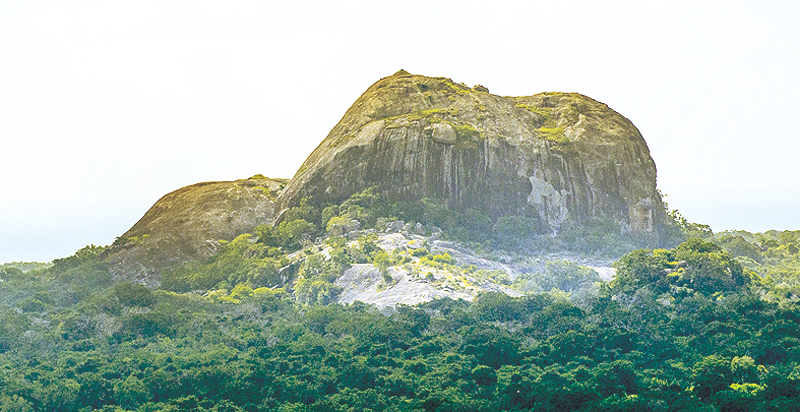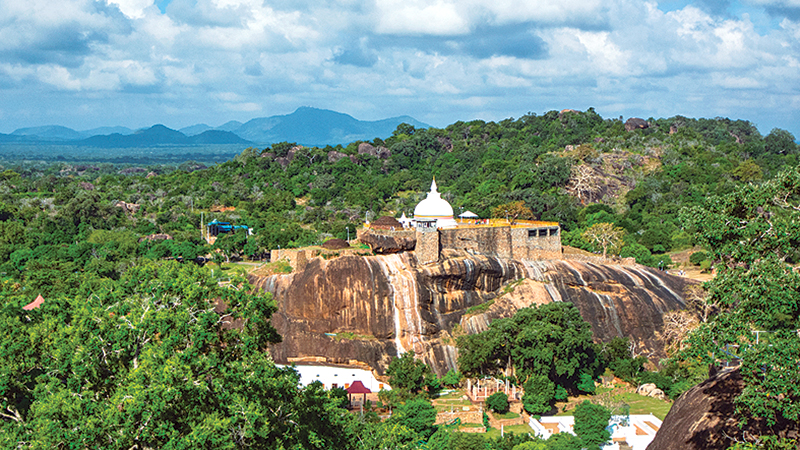The Ruhuna National Park encompasses a sprawling area comprising Yala Blocks I, II III, IV, V and the Yala East National Park, totalling an extent of nearly 122,000 hectares. In addition to these strict Natural Reserves, with three other sanctuaries: the Kudumbigala, Katagamuwa and Kataragama, the total extent comes to about 158,000 hectares.
This whole area of the Southern Province, is nestling in the epic Ruhunu Rata. The two principal rivers that flow between these protected areas are the Menik Ganga and the Kumbukkan Oya. Tracing the ancient history of this Ruhuna National Park, it had been veritable seat of a bubbling civilisation dating back to the pre-Christian era of the 2nd century.
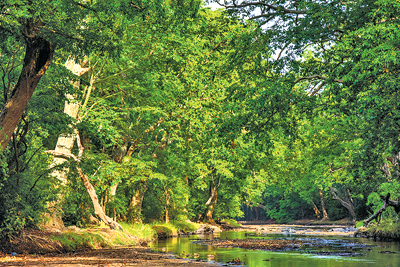
The Kumbukkan Oya in the Yala National Park
Many are the legends that speak of this ancient territory covering the National Park. The Earliest settlers coming down from Prince Vijaya (of the 6th century BC.), the progenitor of the Sinhala race, in legend, are believed to have had their settlements on the bank of the Menik Ganga and Kumbukkan Oya.
Folktale tells us that Prince Vijaya landed at the ancient Southern port of Magama (estuary of the Kirindi Oya) and so did Vijaya’s successor, Prince Panduvasudeva and his consort Princess Baddacakkana and her retinue of brothers who had landed there and made their way towards Upatissagama in Anuradhapura. That is history and legend as narrated in our chronicles such as Mahavamsa and Rajavaliya.
Brahakmanatota
Even Brahmins from India had come to Kataragama, then known as Kajaragama along this ancient sea route and riverine of Kiridi Oya, Menik Ganga and Kumbukkan Oya. By the Menik Ganga in Block I of the National Park is named a tota (a ford) called Brahakmanatota which is quite suggestive as a landing place of Brahmins in ancient times. In Block II, there is a prehistoric site at Minihagalkanda where on a lofty cliff, stone implements, fossilised shells have been discovered dating back to the Miocene age.
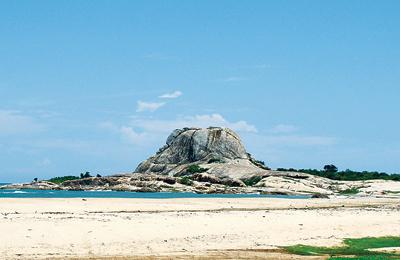
Palutapana stands out today as a reminder of
the ancient Ruhuna Rata
In my previous articles, I had been mostly concentrating on the geographical sequences emerging from the Hambantota to the Moneragala districts, where these ancient and archaeological places have been sited. Since the Yala or Ruhuna National Park is close proximity to Kataragama, I have deviated from Kataragama to Yala to discourse upon its historicity and other legends linked to it. In this instance, I shall devote myself to the well-known archaeological and historical sites in the National Park of Ruhuna (Yala).
The Magul Maha Vihara: Last week I presented my story on this rock cave shrine which is dates back to the 2nd -3rd century BC, of King Kavantissa and Dutugemunu eras of Ruhunu Rata. This Vihara site is in Block I of the Ruhuna National Park.
Sithulpauwa: Of all the archaeological ruins, the most noteworthy archaeological artefacts are found in this large rock outcrop called Sithulpauwa. Sithulpauwa harbours a mass of such valuable ruins. The builders of these stupas, the rock hermitage and monastery establishments are attributed to Kings Kavantissa and Dutugemunu of the 2nd century BC. It is said in ancient chronicles that Sithulpauwa in ancient times was named Cittalapabbata which had been the hallowed abode of 12,000 Arahats (highest sages).
It has numerous rock water pools (Kemas), and consisted nearly ten stupas which are now in ruins. Brahmin inscriptions figured in the rock cave hermitages are many and about 70 such inscriptions have been brought to light by the Archaeological Department in its excavation and restoration works.
Striking sentinel
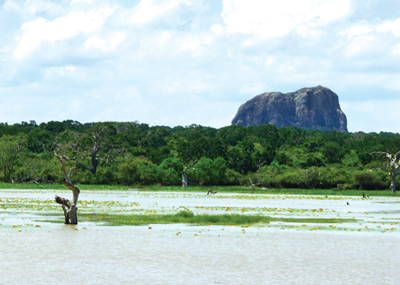
The Akasa Chaitya/Elephant Rock in the heartland
of the Yala Plains in Block I
The past and present bhikkhus of the Sithulpauwa Vihara had left no stone unturned to get this ancient temple restored to its pristine state, by dedicating themselves to all the restoration work conducted by the Department of Archaeology. This archaeological site is in Block I of the Ruhuna National Park.
Akasa Chaitiya: The other rock boulder that stands as a striking sentinel sheltering a host of ancient ruins is the well-known Akasa Chaitiya which is in the heartland of the Yala Plains in Block I of the National Park. It lies about six kilometres North of Sithulpauwa.
It is also called Elephant Rock/Akasa Chaitya. Its meaning is well defined in Dr. R. L. Brohier’s fascinating book, titled ‘Seeing Ceylon’ as “the temple with sky borne Dagaba”. In the same book, Dr. Brohier quotes thus: “Leopold Ludovici one time surveyor climbed this rock using staging and ladders for purpose connected with the trigonometrical survey of the island, in the latter half of the century. The ruins on the summit proved that there must have been a timber stairway which provided access to the top in pre-Christian times”.
Fragments of the stupa that were built on its summit still remain. Its builder is said to be King Kavantissa of Ruhunu Rata. Its local name, Elephant Rock has a twofold meaning. One is that it is shaped as a figure of an elephant and the other that the well-known lone elephant is seen here against the backdrop of the Akasa Chaitiya. Many wildlife photographers have taken classic photos at close range of this loner silhouetted against its backdrop.
Patnagala: Another rock outcrop is called Patnagala which in ancient times was called Patunagala. Remains of dagabas, steps cut on rock outcrops are observed here. All these ruins date back to the reign of King Kavantissa of the 2nd century BC. Its bay was called Patunagala in older times. It had been more of an anchorage that served the sailing vessels that called over there for barter trade in spices and precious stones.
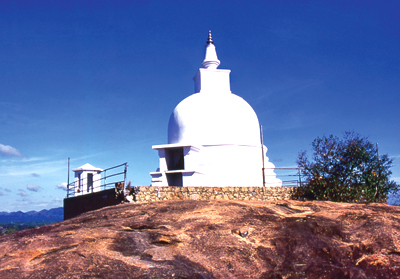
A small Dagaba on the Kuda Situlpauwa summit
The archaeological sites lying in Block I are Palutapana, Silavakanda, Pimburumalkanda and Gonagala. Of these sites, Palutapana stands out as a reminder of a fortress and battleground against the Chola who had made incursions into the region in ancient times.
Coming to Seelawakanda, Pimburumalkanda and Gonagala where there are varied ruins ranging from restored Buddha statues, stone pillars, rock cave hermitages with drip-ledges and Brahmi inscriptions of 2nd -3rd century BC to the remains of Dagabas, ‘Kemas’ rock pools.
Splendid kingdom
All these relics show that one time, particularly in the reign of King Kavantissa of the pre-Christian eras of 2nd century, this whole of the Yala plains must have been a splendid kingdom not only filled with stupas, Dagabas, hermitages, but also with sprawling rice fields watered by the Menik Ganga and Kumbukkan Oya which were harnessed resourcefully.
Among the historical sites in Block II, vast archaeological relics have been discovered. Among them are Katupila, a dagaba in ruins of the 2nd century BC which lies close to the crossing of Katupila Ara.
In Block III of the National Park, many archaeological objects in the form of Dagabas, rock cave hermitages, Brahmin inscriptions, stone columns and Buddha statues have been unearthed.
Such archaeological sites are in Pilmagala, Maha Pilmagala, Kiriwadumanela, Thalaguruhela, Lunuathugalge and Mayagala. All these remains belong to the 2nd century BC.Coming to Block IV and V, at Dikkandanagala and Veheragala are also observed to have remains of Dagabas, stone pillars of the 2nd century BC.
The Yala National Reserve is unique in its archaeological finds and holds a wealth of relics reminiscent of the ancient hydraulic heritage.
